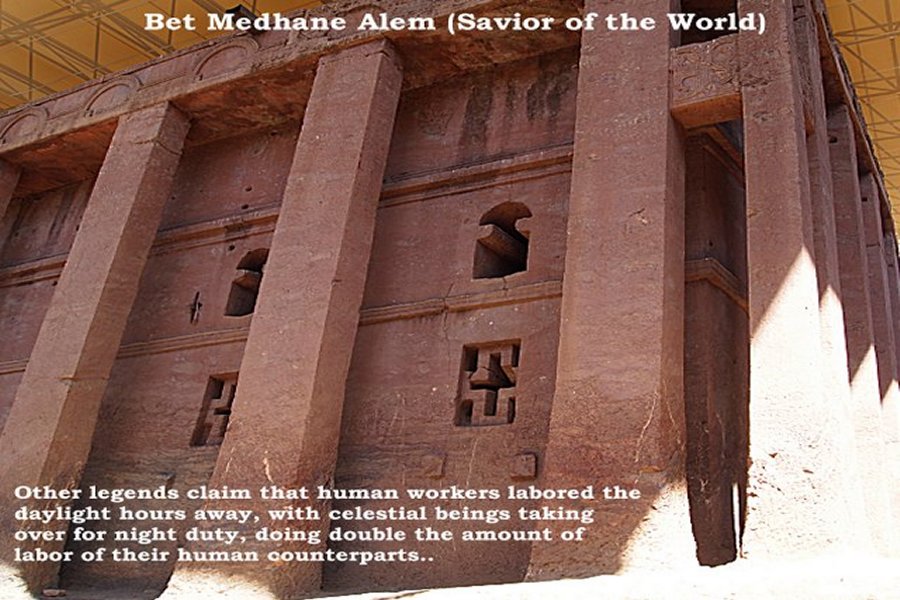Rock-Hewn Ancient Churches Of Lalibela
A. Sutherland - AncientPages.com - There are eleven medieval monolithic churches in Lalibela, one of Ethiopia's holiest cities, second only to Axum.
The construction of the churches is dated somewhere between the 1150s and the 1170s, during the reign of king Lalibela, one of the most famous rulers of Ethiopia's Zagwe Dynasty. In fact, the ancient town of Roha, was named after king Lalibela himself upon his death.
These truly amazing structures - undoubtedly a masterwork in the history of rock-cut architecture, are located about 500 miles (800 kilometers) north of Addis Abeba and halfway up on Roha Mountain.
But how did Lalibela build these churches? Many theories and legends propose different answers and naturally, there are some legends.
According to an Ethiopian legend, God instructed Lalibela to build the unique churches; the structures were built with the help of angels. King Lalibela, who was poisoned by his brother and fell into a three-day coma, was taken to Heaven and given a vision of a rock hewn city. After Lalibela woke up from the comma and was crowned as a king, he gathered local handymen and started building the churches, the like of which the world had never seen before.
Another legend has it that that the king went into exile to Jerusalem and vowed that when he returned he would create a New Jerusalem. At that time, Muslims conquests halted Christian pilgrimages to the Holy Land making them often dangerous and even deadly.
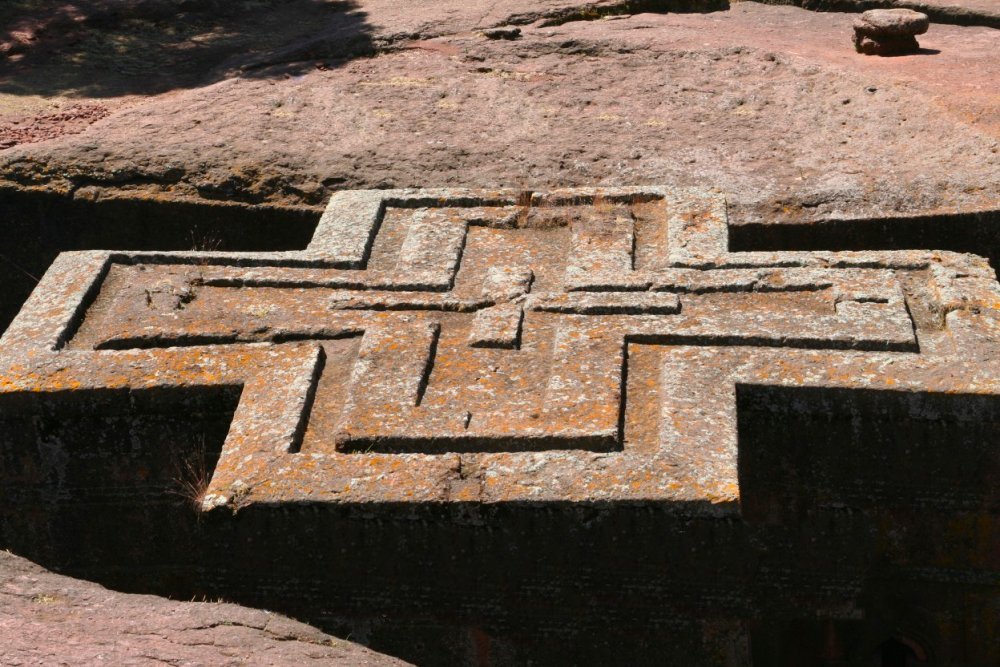
Church of St. George (or Church of Bete Geiorgis). There are some striking features on the roof, in form of five crosses
nestled inside each other and continuously being magnified from the inside to the outside.
According to the local Church fathers, when king Lalibela was ready, a pillar of light came from heaven, showing him the place where he was to built the first church.
Some scholars estimate it would have taken a 40,000 man workforce to build the churches; local legends claim that human workers labored the daylight hours away, with celestial beings taking over for night duty, doing double the amount of labor of their human counterparts, enabling the churches to be built at incredible speed.
The design of these eleven 'medieval' churches is indeed very unique. Each church of the eleven rock-hewn churches also still has its original tabot from the time of Lalibela. A tabot is an important item in the worship of the Ethiopian Orthodox Church: it is a replica of the Ark of the Covenant described in the Holy Bible.

The Church of St. George is the most well known and last built of the eleven churches. The dimensions of the complex are 25 meters by 25 meters by 30 meters (82x82x98 ft), and there is a small baptismal pool outside the church, which stands in an artificial trench.
On the roof of the famous Church of St. Georges,there are some striking features, in form of five crosses nestled inside each other and continuously being magnified from the inside to the outside.
Another architectural achievement is the built-in drainage system. During the rainy seasons, water does not collect on the building, instead it is being drained from the roof through a system of small channels and openings.
See also:
900-Year-Old Crypt, Magical Inscriptions And Mysterious Signs At Old Dongola, Sudan
Some of them lie almost completely hidden in deep trenches, while others stand in open quarried caves. A complex and amazing labyrinth of tunnels and narrow passage ways connects them all.

Bete Amanuel - The ancient stone master builders did not construct them in a traditional way. Instead they cut the buildings from a single piece of granite below ground level and chiselled out, forming windows, doors, floors, catacombs and other areas of the buildings.
Yet they are different from one another - in both size and style. What do we know about the Medieval stone masons whose ingenuity created these structures? What tools were used to build them?
This architectural miracle would never be possible to establish within the lifetime of one king and with contemporary prehistoric hand tools, only. Who built the amazing churches of Lalibela and how it was done remains totally unclear.
One theory propose that the structures produced solely by medieval Ethiopian civilization but who supplied the drawings remains a mystery.
So far, the churches of Lalibela continue to baffle historians and archaeologists.
Written by – A. Sutherland AncientPages.com Senior Staff Writer
Copyright © AncientPages.com All rights reserved. This material may not be published, broadcast, rewritten or redistributed in whole or part without the express written permission of AncientPages.com
Expand for referencesMore From Ancient Pages
-
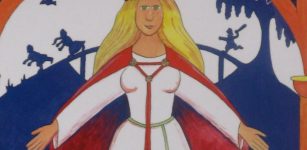 Lofn ‘Matchmaker’ – Norse Goddess Of Forbidden Marriages Of People Who Wish To Be Loved And Search For Partners
Featured Stories | Mar 25, 2021
Lofn ‘Matchmaker’ – Norse Goddess Of Forbidden Marriages Of People Who Wish To Be Loved And Search For Partners
Featured Stories | Mar 25, 2021 -
 Mada’in Saleh: Spectacular Rock-Cut Tombs And Monuments Reflect Great Skills Of Nabataean Builders
Featured Stories | Aug 18, 2020
Mada’in Saleh: Spectacular Rock-Cut Tombs And Monuments Reflect Great Skills Of Nabataean Builders
Featured Stories | Aug 18, 2020 -
 Ancient Cotton Fibers Dating Back 7,000 Years Discovered In NE Israel
Archaeology | Dec 19, 2022
Ancient Cotton Fibers Dating Back 7,000 Years Discovered In NE Israel
Archaeology | Dec 19, 2022 -
 New Study Reveals Who Destroyed New York’s First Dinosaur Museum
News | May 29, 2023
New Study Reveals Who Destroyed New York’s First Dinosaur Museum
News | May 29, 2023 -
 Climate Change May Have Impacted The Rise And Fall Of Middle Eastern Civilizations
Archaeology | Jan 19, 2023
Climate Change May Have Impacted The Rise And Fall Of Middle Eastern Civilizations
Archaeology | Jan 19, 2023 -
 Extraordinary Gold Treasures Found In A Thracian Warrior’s Grave Near Topolovgrad, Bulgaria
Archaeology | Aug 26, 2024
Extraordinary Gold Treasures Found In A Thracian Warrior’s Grave Near Topolovgrad, Bulgaria
Archaeology | Aug 26, 2024 -
 Discovered 3,700-Year-Old Clay Tablet Shows Babylonians Used Geometry Long Before Pythagoras
Archaeology | Aug 4, 2021
Discovered 3,700-Year-Old Clay Tablet Shows Babylonians Used Geometry Long Before Pythagoras
Archaeology | Aug 4, 2021 -
 Top 10 Discoveries About Our Ancient Ancestors In 2023
Archaeology | Dec 29, 2023
Top 10 Discoveries About Our Ancient Ancestors In 2023
Archaeology | Dec 29, 2023 -
 6,000-Year-Old Discovery Of Artifacts Associated With Ancient Lengyel Culture
Archaeology | Mar 27, 2020
6,000-Year-Old Discovery Of Artifacts Associated With Ancient Lengyel Culture
Archaeology | Mar 27, 2020 -
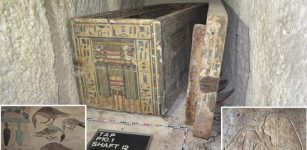 Magnificent Burial Chamber Of Idy, Ancient Egyptian Priestess Of Goddess Hathor Discovered In Asyut
Archaeology | Nov 15, 2024
Magnificent Burial Chamber Of Idy, Ancient Egyptian Priestess Of Goddess Hathor Discovered In Asyut
Archaeology | Nov 15, 2024 -
 ‘Sophisticated’ 4,000-Year-Old Steppe Pyramid Discovered In Kazakhstan
Archaeology | Aug 12, 2023
‘Sophisticated’ 4,000-Year-Old Steppe Pyramid Discovered In Kazakhstan
Archaeology | Aug 12, 2023 -
 ‘Face Of First European’ – Oldest Fossil Of European Human Ancestor Found At Spain’s Atapuerca Archaeological Site
Archaeology | Jul 9, 2022
‘Face Of First European’ – Oldest Fossil Of European Human Ancestor Found At Spain’s Atapuerca Archaeological Site
Archaeology | Jul 9, 2022 -
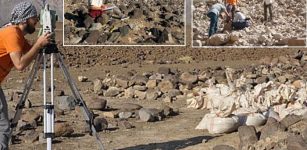 Evidence Of Copper Processing Unearthed At Archaeological Site In Oman
Archaeology | Mar 6, 2024
Evidence Of Copper Processing Unearthed At Archaeological Site In Oman
Archaeology | Mar 6, 2024 -
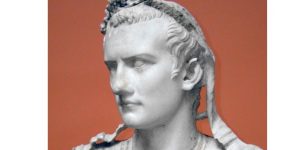 On This Day In History: Roman Emperor Caligula Was Born – On August 31, 12 AD
News | Aug 31, 2016
On This Day In History: Roman Emperor Caligula Was Born – On August 31, 12 AD
News | Aug 31, 2016 -
 7,000-Year-Old Unique Lipnik Idol Statuette Unearthed In Moravian Gate Valley, Czech Republic
Archaeology | Dec 14, 2015
7,000-Year-Old Unique Lipnik Idol Statuette Unearthed In Moravian Gate Valley, Czech Republic
Archaeology | Dec 14, 2015 -
 Huge Phitos (Jar) Unearthed In Ancient City Of Prusias ad Hypium, Turkey
Archaeology | Jun 26, 2022
Huge Phitos (Jar) Unearthed In Ancient City Of Prusias ad Hypium, Turkey
Archaeology | Jun 26, 2022 -
 ‘Flower Burial’ And Shanidar Cave With Neanderthal Remains Who Lived 70,000 Years Ago
Archaeology | Feb 19, 2020
‘Flower Burial’ And Shanidar Cave With Neanderthal Remains Who Lived 70,000 Years Ago
Archaeology | Feb 19, 2020 -
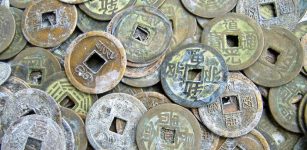 Our Lives Have Always Been Manipulated By Money – Part 1
Featured Stories | Jun 2, 2022
Our Lives Have Always Been Manipulated By Money – Part 1
Featured Stories | Jun 2, 2022 -
 Unlocking The Secrets Of Lost Prehistoric Land Hidden Beneath The Sea
News | Sep 8, 2015
Unlocking The Secrets Of Lost Prehistoric Land Hidden Beneath The Sea
News | Sep 8, 2015 -
 Ancient Human Remains A The Sima De Los Huesos Site Investigated
Archaeology | Mar 15, 2023
Ancient Human Remains A The Sima De Los Huesos Site Investigated
Archaeology | Mar 15, 2023

